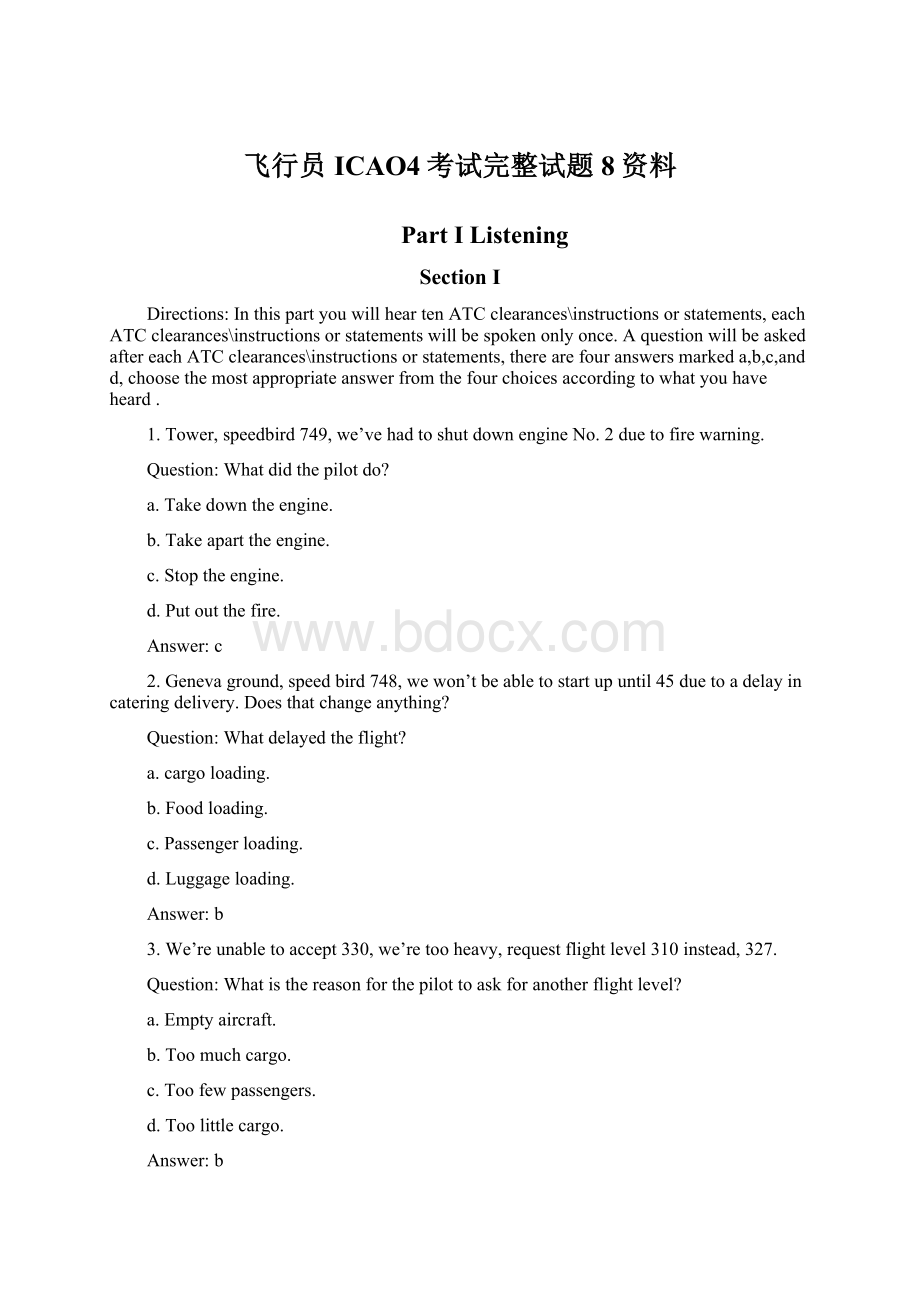飞行员ICAO4考试完整试题8资料.docx
《飞行员ICAO4考试完整试题8资料.docx》由会员分享,可在线阅读,更多相关《飞行员ICAO4考试完整试题8资料.docx(17页珍藏版)》请在冰豆网上搜索。

飞行员ICAO4考试完整试题8资料
PartIListening
SectionI
Directions:
InthispartyouwillheartenATCclearances\instructionsorstatements,eachATCclearances\instructionsorstatementswillbespokenonlyonce.AquestionwillbeaskedaftereachATCclearances\instructionsorstatements,therearefouranswersmarkeda,b,c,andd,choosethemostappropriateanswerfromthefourchoicesaccordingtowhatyouhaveheard.
1.Tower,speedbird749,we’vehadtoshutdownengineNo.2duetofirewarning.
Question:
Whatdidthepilotdo?
a.Takedowntheengine.
b.Takeaparttheengine.
c.Stoptheengine.
d.Putoutthefire.
Answer:
c
2.Genevaground,speedbird748,wewon’tbeabletostartupuntil45duetoadelayincateringdelivery.Doesthatchangeanything?
Question:
Whatdelayedtheflight?
a.cargoloading.
b.Foodloading.
c.Passengerloading.
d.Luggageloading.
Answer:
b
3.We’reunabletoaccept330,we’retooheavy,requestflightlevel310instead,327.
Question:
Whatisthereasonforthepilottoaskforanotherflightlevel?
a.Emptyaircraft.
b.Toomuchcargo.
c.Toofewpassengers.
d.Toolittlecargo.
Answer:
b
4.Memphiscenter,continental327,wearemakinganemergencydescenttoflightlevelonezerozeroduetosuddendecompression.
Question:
Whatistheproblemof327?
a.Hydraulicproblem.
b.Airframedamage.
c.Enginefailure.
d.Windowbroken.
Answer:
d
5.Control,Delta443,severalpassengershavelostconsciousness‘causeanumberofoxygenmasksdidn’tdrop.
Question:
Whathappenedonboard?
a.Anumberofpassengerswereindanger.
b.Anumberofpassengersdidn’tknowhowtobreathe.
c.Severalpassengers’oxygenmasksdisappeared.
d.Severalpassengersdroppedtheirmasks.
Answer:
a
6.Pariscontrol,Sabena207,we’reclearofthebuildup,canwedeviatetotherightontoheading190andcontinueonthatheadingfor30nauticalmilestoflyparalleltoalineofsqualls,thenproceeddirecttoBSN?
Question:
Whatisthepilotintendingtodo?
a.Tryingtochangetheflightplan.
b.Tryingtoflytoanotherholdingpoint.
c.Tryingtoavoidweather.
d.Tryingtoconnectthediscontinuity.
Answer:
c
7.Alaska268,radarserviceisterminated,oneeightymilessoutheast,squawk1210,goodday.
Question:
Whatwillthepilotdo?
A.Tobereadytoflywithradarvector.
B.Toflywithoutradarvector.
C.Tomaneuverforidentification.
D.ToflywithoutATCservice.
Answer:
b
8.American248,Memphisdeparture,radarcontact,climbandmaintaineightthousand,leftturn,heading090.
Question:
Whatdoyoulearnfromthemassage?
a.Thecontrolleristryingtofindtheaircraft.
b.Thecontrollertriestoidentifytheaircraft.
c.Thecontrollerhasfoundtheflightontheradar.
d.Thecontrollerisinstructingthepilottomaneuver.
Answer:
c
9.American345,rightheading330,followingmyinstructionsandIwillgetyoubacktoFortworth,Ijustgotabombalertonyouraircraft.
Question:
Whywastheflightrequiredtoreturn?
a.Dueabombonboard.
b.Tocheckifthereisabombonboard.
c.Tocheckthedamageofthebomb.
d.Togetabombontotheaircraft.
Answer:
b
10.Alaska567,Igotapassengerverydrunkonboardandhethreatenstohijacktheaircraft.ComingbacktoSeatac.
Question:
Whatisthereasonforreturn?
a.Thepassengeristoodrunktobeonboard.
b.Thecontrollerwasthreatenedofbeinghijacked.
c.Someonethreatenedtohijackapassenger.
d.Apassengerthreatenedtohijacktheflight.
Answer:
d.
SectionII
Directions:
InthispartyouwillhearfiveRTFexchangesbetweenpilotsandairtrafficcontrollers,eachexchangewillbespokenonlyonce.Aquestionwillbeaskedaftereachexchange,therearefouranswersmarkeda,b,c,andd,choosethemostappropriateanswerfromthefourchoicesaccordingtowhatyouhaveheard.
1.P:
Control,Southwest334,oilpressuredangerouslylowontheNo2engine,canweproceedPortlanddirect?
C:
Affirm,proceedtoTacomadirectatflightlevel130.
Question:
Whathappened?
a.lowoilpressure.
b.Lowfuelpressure.
c.Highoilpressure.
d.Highfuelpressure.
Answer:
a
2.P:
Pacific28,fuelleakontheleftwing,comingback.RequestclearancetoDawsondirect.
C:
ClearedtoDawsonflightlevel150.
Question:
Whatistheproblem?
a.oilleakage.
b.Fuelleakage.
c.Leftwingdamage.
d.Lowfuelquantity.
Answer:
b
3.C:
MikeGolf,unabletohandyouovertoPrestwick.Contactthemon125.6forinstructionsandreverttothisfrequency?
P:
Roger,125.6,mikegolf.
Question:
Whatisgoingon?
a.Thecontrollerisinstructingthepilottochangefrequency.
b.Thecontrollerishandingtheflighttoreceivingcontroller.
c.Thehandoffissuccessful.
d.Thecontrollerfailedtohandtheflighttoreceivingcontroller.
Answer:
d
4.C:
Delta432,remainclearofdangerousareainthevicinityofEdwardsairforcebase.Missilelaunchinginprogress.
P:
Roger,keepmeadviseddelta432.
Question:
Whatisgoingoninthedangerousarea?
a.Anaircrafthasbeenshotdownbyamissile.
b.Amilitaryexerciseisgoingon.
c.Aspaceshuttleisbeinglaunched.
d.Missiledeliverisgoingon.
Answer:
b
5.P:
Takeoffabortedengine2waslowonpower.Canwevacatefirstleft?
C:
Doyouwishtotaxibacktotheapronortothethresholdof25?
P:
Backtorunway25,please.
C:
Fine.Firstleft.Contactground121.9fortaxiinstructions.
Question:
Whatdoyoulearnfromthemessages?
a.Thepilotisgoingbacktotheapron.
b.Thepilotisgoingtovacatetherunway.
c.Thepilothasalowpressureproblem.
d.Thepilothasataxiingproblem.
Answer:
b
SectionIII
Directions:
Inthissectionyouwillheartwopassages.eachpassagewillbespokenonlyonce.Aftereachpassagefivequestionswillbeasked,foreachquestiontherearefouranswersmarkeda,b,c,andd,choosethemostappropriateanswerfromthefourchoicesaccordingtowhatyouhaveheard.
PassageI
Oneofthemostcomplextasksfacingpilotsoccursneartheendofaninstrumentapproach,whentheymakethetransitionfrominstrumenttovisualflying.Duringthistransition,theymustlocatetherunwayandproperlymaneuvertheaircraftforlandingwithinseconds.Withinthisshorttime,thepilotmustlocatetherunway,determinetheaircraft’sposition,makeanynecessaryadjustmentsinflightattitude,andthenlandtheaircraft.Withoutsomeformofvisualassistance,thistaskisvirtuallyimpossibletoperformsafelyinsoshortatime.
Theseproblemswerenotedasearlyas1932byofficialsfromtheairlinesandtheBureauofAirCommerce.Experimentswereconductedasearlyas1935inanattempttosimplifythetransitionfrominstrumenttovisualflightduringanapproach.Theseexperimentsledtotheconstructionofanumberofdifferenttypesofapproachlightssystems.Approachlightsareplacedalongtheextendedcenterlineoftherunwayandusuallyextendfromtherunwaythresholdouttoapointwherethepilotmightmakethetransitionfrominstrumenttovisualflying.Approachlightsystemsaredesignedtoprovidethepilotwithvisualcuesthatwillpermitaccurateaircraftcontrolduringthefinalapproachandlandingphaseoftheflight.
Thefollowingquestionsarebasedonthepassageyouhavejustheard.
1.Accordingtothepassagewhatistheimporttransition?
a.Fromvisualtoinstrumentflying.
b.Frominstrumenttovisualflying.
c.Fromapproachtolanding.
d.Fromtakeofftoclimbout.
Answer:
b
2.Whatdidtheexperimentmentionedinthepassageleadto?
a.Simplifyingthetransition.
b.Simplifyingtheapproach.
c.Cancelingthetransition.
d.Establishingthelightingsystem.
Answer:
d
3.Accordingtothepassagewhatcanprovidepilotswithlandingcues?
a.Landinglights.
b.Approachlights.
c.Navigationlights.
d.Noneoftheabove.
Answer:
b
4.Whatcanwelearnfromthispassage?
a.Nopilotcanflywithoutvisualassistance.
b.Approachlightingsystemwasestablishedbeforetheexperiment.
c.Thepilotsrequiredestablishingthelightingsystem.
d.Approachlightsprovidevisuallandingcues.
Answer:
d
5.Whatisthecorrecttitleforthepassage?
a.Howwehadapproachlights.
b.Howthesafelandingisachieved.
c.Visualassistanceisvital.
d.Flyingisimpossiblewithoutlights.
Answer:
a
PassageII
Helicopterscantaxiaroundtheairportbygroundtaxiing,hovertaxiing,orairtaxiing.Groundtaxiingissimilartothatofataxiingplane.Onlythosehelicoptersequippedwithlandinggearareabletogroundtaxi.Inhovertaxiingthehelicopterremainswithin50feetoftheground,andinairtaxiing,below100feet.
Eachtypeoftaxiinghasitsadvantagesanddisadvantages.Groundtaxiingisthemostfuelefficientofthethreeandcreateslessairturbulencearoundandbehindthehelicopter.Hovertaxiingismuchfasterthangroundtaxiingbutcreatesahighlevelofairturbulencebothbelowandbehindthehelicopter.Airtaxiingisthefastestmethodandactuallycreateslessairturbulencesincethehelicopterisatagreateraltitudeandmostoftheairturbulenceisdirectedbackward.Wheneverahelicopteristaxiing,aircraftnearitshouldbenoticedthatitcouldbecreatingwaketurbulence.
Thefollowingquestionsarebasedonthepassageyouhavejustheard.
1.Whichisthemostfuelefficienttaxiing?
a.Groundtaxiing.
b.Hovertaxiing.
c.Airtaxiing.
d.Ahelicoptercannottaxi.
Answer:
a
2.Whichtypeoftaxiingcreatesthehighestlevelofturbulence?
a.Groundtaxiing.
b.Hovertaxiing.
c.Airtaxiing.
d.Noturbulenceuntilliftoff.
Answer:
b
3.Whichisthebestmethodforahelicoptertotaxi?
a.Groundtaxiing.
b.Hovertaxiing.
c.Airtaxiing.
d.Itisnottoldinthepassage.
Answer:
d
4.Whatis